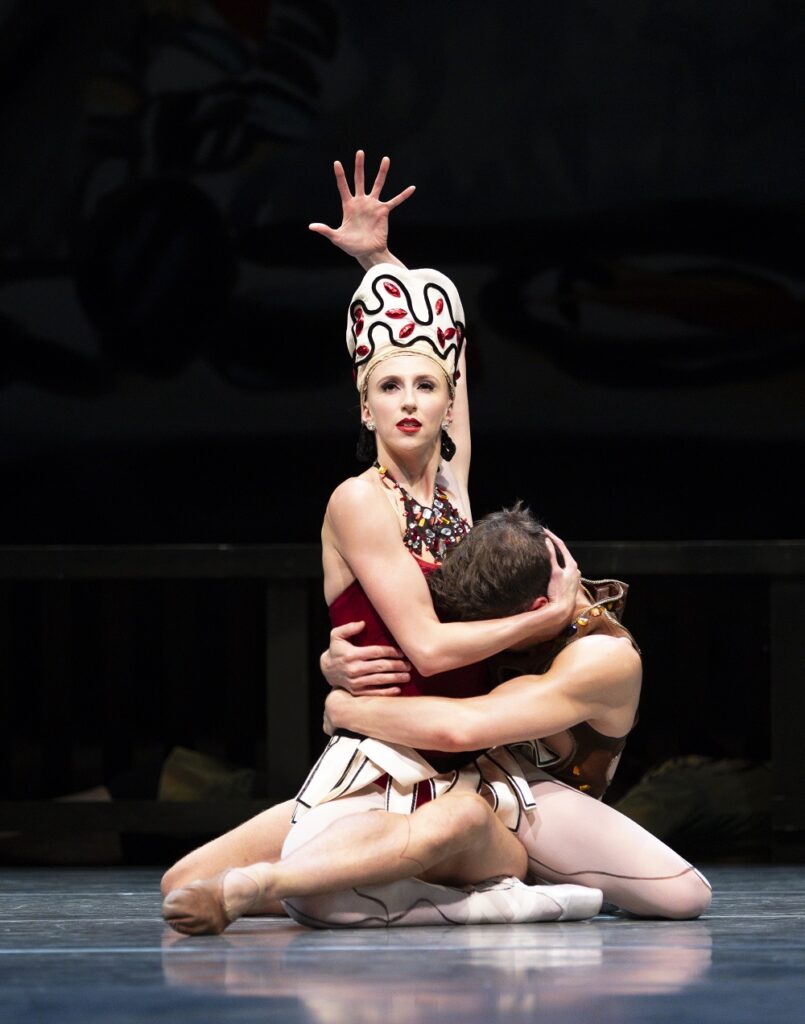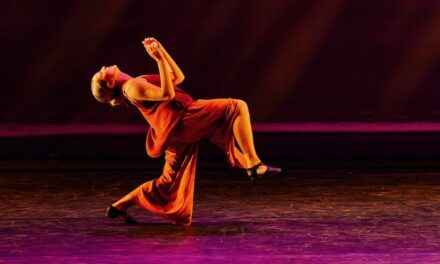Always a treat, the Pacific Northwest Ballet’s Season makes this Fall that much more exciting with its “All Balanchine” program. Their brilliant Artistic Director, Peter Boal, who has inspired PNB’s growth since 2005, has soldiered on with the help of the Ellen Walker, Executive Director and Kiyon Ross, Assoc. AD and the generous funders. Under his umbrella, he has nurtured and developed a company of outstanding soloists and corps members; encouraging PNB’s impressive orchestra led by Emil de Cou; amazing costume designers and craftswomen and men, lighting and set Designers and the eclectic talent of masterful choreographers that make this company one of the finest in our country.
This 2024 season presents three works of the prolific genius George Balanchine; Square Dance and The Prodigal Son, Staged by Peter Boal, himself a principal with the New York City Ballet under Balanchine, and Igor Stravinsky’s Violin Concerto, Staged by Colleen Neary, a soloist with Balanchine’s Company from 1969-1979 and a member of the George Balanchine Trust.
Boal and Neary do a yeoman’s job of reconstructing the classic pieces not seen on a regular basis. Square Dance, the opening piece, is a Baroque homage to the music of Antonio Vivaldi and Arcangelo Corelli, cross-pollinating Balanchine’s love for American dance with Baroque music. The first movement begins with the entire company trading places, with sprightly footwork and Balanchine’s genius staging of angles, squares and circles joyously filling the stage. It is led by Principal dancers, Leta Biasucci and Kyle Davis with 12 Corps members.

Pacific Northwest Ballet principal dancers Leta Biasucci and Kyle Davis in “Square Dance”, choreography by George Balanchine © The George Balanchine Trust – Photo © Angela Sterling.
Balanchine used Square Dance Callers to help develop the “supple sharpness” and “high spirit” along with the physical designs and shapes of the piece. Premiered on November 21, 1957 with Patricia Wilde and Nicolas Magallanes, who were the dance version of the “callers,” along with 12 corps (square) dancers, they presented his vision of Americana. Later, with the help of the callers, the orchestra formerly onstage was placed in the pit and the Caller was removed completely. In the later revamping in 1976 Balanchine then added a poignant and introspective solo for the male lead, finalizing the latest version.
However, no matter if the dancers who did his work were the caliber of artists like Baryshnikov, Nureyev or Bruhn, Balanchine always clarified that “his choreography was the star, not the individuals who danced it.” Patricia Neary quoted Mr. B as saying: “The only reason they [the audience] should come, is to see my choreography.” And true to his wishes, the repetiteurs of the Balanchine Trust are dedicated to the musicality, artistry and technical brilliance that needs to be adhered to deliver his vision.
In this particular ballet, where tight, very clear steps, epaulement (shouldering), ballon (bounce), etc., requires near mirror-image corps work, the dancers must dance as one. PNB is clearly made up of individually unique dancers, as opposed to the New York City Ballet members who look and are trained to move as one with the artistry of the soloists under the watchful eye of the repetiteurs. So as wonderful as, Leta Biasucci, Kyle Davis and the 12 Corps members were, and as fun as it was to see the soloists precede the calls to the corps, the difference is, at points elongated nuances, when briskness was called for, among other subtleties. It clearly defined a difference in the execution of this particular Balanchine ballet.

Pacific Northwest Ballet principal dancer Lucien Postlewaite in the title role of “Prodigal Son”, choreography by George Balanchine © The George Balanchine Trust – Photo © Angela Sterling.
In the Prodigal Son, created by Balanchine in his twenties for Diaghilev’s Ballet Russes, with music by Sergei Prokofiev (1928-29), unfortunately was never seen by the great impresario, who died in 1929. The Libretto, based on the Gospel of Luke by Boris Kochno, fashioned the themes of sin and redemption. The Ballet, staged by Boal, who himself had performed the son, did a superb job directing the role of the obstinate youth, in his intemperance and eventual downfall. The classic scenic and costume design by Georges Rouault was sparse and perfect, with lighting design so painterly and beautiful by Randall G. Chiarelli.

Pacific Northwest Ballet principal dancers Elle Macy as the Siren, with Lucien Postlewaite in the title role of “Prodigal Son”, choreography by George Balanchine © The George Balanchine Trust – Photo © Angel Sterling.
Prodigal Son, one of this writer’s favorites, having seen Edward Villella do the ballet at the height of his career, was a wonderful surprise. The son, played by the spirited dancer/actor Lucien Postlewaite, was so plucky, sensual and compelling as to guide the story to the moving ending and into the arms of his father, played by the towering Miles Pertl. The plumb role of the seductive Siren, played by Elle Macy, was appropriately icy and wicked as she towered over Postlewaite. Betrayed by his drinking buddies, Christian Poppe and Price Suddarth, who staggered into an off balanced pas de deux, reversed their loyalties to join the Siren’s stomping “Goons” (Luca Anaya, Dylan Calahan, Mark Cudihee, Lucas Galvan, Connor Horton, Larry Lancaster, Drew Lybolt, Jon Morrill, Samuel Portillo). Then the wayward son, on his knees, crawls back to and into his father’s arms as he is shrouded and forgiven. This is not only a classic ballet that is to be treasured, but a parable so beautifully crafted as to indel itself in one’s mind and heart.
And the final gift was the Stravinsky Violin Concerto that was originally premiered on June 18, 1972 at the New York State Theater as part of the tribute to Stravinsky and his music after his death. The vitality of the piece, beautifully conducted by Emil de Cou, floats the violin throughout Stravinsky’s remarkable score, played by the virtuosic violinist and concert master, Michael Jinsoo Lim.

Pacific Northwest Ballet principal dancer Elle Macy and soloist Christopher D’Ariano in “Stravinsky’s Violin Concerto”, choreography by George Balanchine © The George Balanchine Trust – Photo © Angela Sterling.
The casting is Elle Macy who dances the Karin Von Aroldingen’s role as tall woman in the first Aria to partner with Christopher D’Ariano, originally done by Jean Pierre Bonnefous. While Angelica Generosa is cast as the petite woman in the second aria, originally danced by Kay Mazzo. Dylan Wald is casted in Peter Martins role as the tall man and is Generosa’s partner in the second aria. In the opening Toccata identified by its full chords, rapid runs, and harmonies showing off this virtuosic musical work, the four lead dancers pair off with the four-person corps for each of the soloists. The famous arias come next with Macy and D’Ariano, executing almost impossible transitional detailed partnering, lifts, turns, sometimes with stylized squared feet, were not seen before Balanchine’s inventions at the time. Unique and complex, the couple wends their way, ending as though it took hardly any effort at all.
From there comes the famous duet with Generosa and Wald, hardly ever losing contact in their co-dependency and after as the twists and turns end as described perfectly, “The ballerina clings to her partner, wrapping herself around him then standing sheltered in his arms. At the end of the movement he kneels and she leans against him, his arm curved over her like a blindfold.” (J. Anderson’s review) Wald slowly supports her with her back arched and slowly backs away from her to end the pas de deux with a fade.
The ballet then ends with a Capriccio featuring the entire cast of dancers in a rousing folk dance replete with joyous rounds, footwork and folded arms, then ending in lines nearly poised to continue again before the formal bow to a cheering audience.
PNB has offered a gift to the West Coast with its serious artful dedication to classics that, when reflected upon, allows the viewers to see, understand and appreciate the good fortune of these pieces of creative genius, hopefully to remember and exist through generations to come.
PNB dancers:
Principals: Jonathan Batista, Leta Biasucci, Kyle Davis, Angelica Generosa, Cecilia Iliesiu, Elle Macy, Elizabeth Murphy, Lucien Postlewaite, Sarah-Gabrielle Ryan, Dylan Wald.
Soloists: Madison Ryan Abel, Damiel Cruz-Garrido, Christopher D’Ariano, Luther DeMyer, Amanda Morgan, Miles Pertl, Christian Poppe, Clara Ruf Maldonado, Kuu Sakuragi, Price Suddarth, Leah Terada.
Corps de Ballet: Luca Anaya, Malena Ani, Emerson Boll, Dylan Calahan, Ryan Cardea, Mark Cuddihee, Ashton Edwards, Melisa Guilliams, Connor Horton, Zsilas Michael Hughes, Rosalyn Hutsell, Kali Kleiman, Larry Lancaster, Audrey Malek, Noah Martzall, Joh Morrill, Ginabel Peterson, Samuel Portillo, Juliet Prine, Yuki Takahashi, Genevieve Waldorf, Lily Wills, Destiny Wimpye.
To learn more about Pacific Northwest Ballet, please visit their website.
Written by Joanne DiVito for LA Dance Chronicle.
Featured image: Pacific Northwest Ballet company dancers in Stravinsky’s Violin Concerto, choreography by George Balanchine © The George Balanchine Trust – Photo © Angela Sterling.







